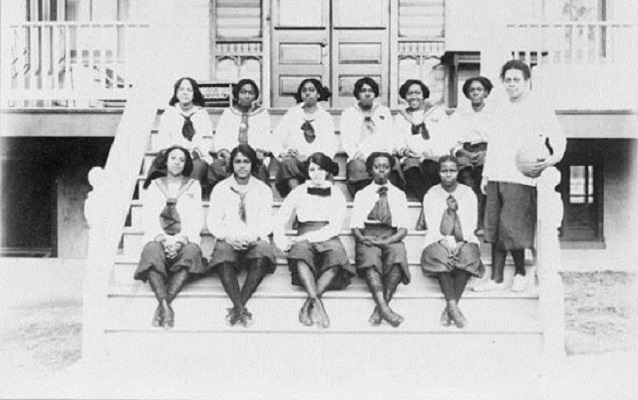Last updated: November 13, 2020
Place
Trades Hall of National Training School for Women and Girls

Founded in 1909, the National Training School for Women and Girls educated black women from around the world. Unlike other prominent black schools, such as the Tuskegee Institute, the founders did not request money from white donors. Nannie Helen Burroughs, the daughter of formerly enslaved people, piloted the project. Burroughs wanted each student to become “the fiber of a sturdy moral, industrious and intellectual woman.” She created a vigorous and demanding curriculum of academic and vocational courses. Students could gain experience in the on-campus laundry and the school newspaper. Those enrolled could take a broad range of classes such as dressmaking, handicrafts, power machine operation, public speaking, music, and physical education. Students from Canada, Africa, Haiti and Puerto Rico boarded at the school. Burroughs also operated a missionary training program and Sunday school classes. Burroughs was a devout Baptist and member of the National Baptist Convention’s Women’s Auxiliary. She required students to be practicing Christians. There were no class or skin-color restrictions. Most of the students came from working class families. Championing the principle of self-help, Burroughs provided no scholarships.
Nannie Helen Burroughs was born in Orange, Virginia around 1879. In 1884, she moved with her mother, Jennie, to Washington DC. Burroughs graduated with honors from M Street High School (now Paul Laurence Dunbar High School). Despite her academic achievements, Burroughs was turned down for a Washington D.C. public school teaching position. The elite black community often discriminated against those who had darker skin. Some historians argue this is why Burroughs did not get hired. Instead she decided to open her own school.
Burroughs proposed her school initiative to the National Baptist Convention (NBC). After years of planning, the NBC bought a six-acre parcel of land in Northeast Washington, D.C. Burroughs raised money from within the black community. She did not, however, have unanimous support. Prominent civil rights leader Booker T. Washington did not believe black Washingtonians would contribute to the project. Others disagreed with the training of women beyond domestic work. An inspiring speaker, Burroughs managed to raise enough money to open the school. There were few large donations. Most of the money was donated in small amounts by black women and children.
During the first half of the 20th century the school gained in prominence. Premier black history scholar, Dr. Carter G. Woodson, became one of its biggest advocates. The Trades Hall was completed in 1928 to replace an old classroom building. The president of the National Association of Colored Women, Mary McLeod Bethune, spoke at the dedication ceremony. The hall housed twelve classrooms, three offices, an assembly area and a print shop. Other public figures such as President Herbert Hoover and Congressman Oscar de Priest, a prominent civil rights activist, encouraged Burroughs’ work.
In May 1961, Burroughs died. She never married and devoted her life to the education of black women. In 1964, the school was renamed the Nannie Helen Burroughs School in her honor. The Trades Hall became a private elementary school, but closed in 2006. The building now houses the Progressive National Baptist Convention. Burroughs defied societal restrictions placed on her gender and race. Her work foreshadowed the main principles of the Civil Rights Movement of the 1960s and 1970s. The Trades Hall is the last physical legacy of her lifelong pursuit for worldwide racial equality.
A recent project through the Underrepresented Community Grant Program, which works to diversify nominations submitted to the National Register of Historic Places (NRHP), funded an effort to recognize the significance Nannie Helen Burroughs' work at the National Training School for Women and Girls through an amendment to the existing NRHP nomination.
Sources:
Fitzpatrick, Sandra & Maria R. Goodwin. The Guide to Black Washington: Places and Events of Historical and Cultural Significance in the Nation's Capital. New York: Hippocrene Books, 2001.
Harley, Sharon. "Nannie Helen Burroughs: 'The Black Goddess of Liberty.'" The Journal of Negro History 81, No. 1 (1996): 62-71.
Taylor, Traki L. “'Womanhood Glorified': Nannie Helen Burroughs and the National Training School for Women and Girls, Inc., 1909-1961,” The Journal of African American History 87 (2002): 390-402.
National Historic Landmark Nomination of the Trades Hall of the National Training School for Women and Girls
National Historic Landmarks (NHLs) are historic places that possess exceptional value in commemorating or illustrating the history of the United States. The National Park Service’s National Historic Landmarks Program oversees the designation of such sites. There are just over 2,500 National Historic Landmarks. All NHLs are also listed in the National Register of Historic Places.
